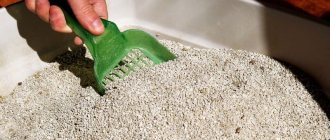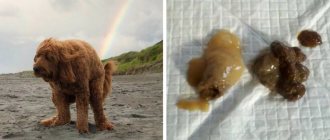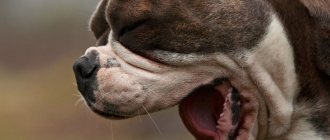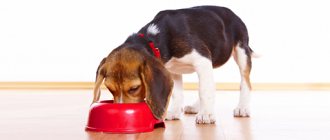Constipation refers to the infrequent passage of dry, hard stool. If bowel movements are delayed and feces remain in the colon for two or three days, the colon removes too much moisture from the material, making elimination difficult and painful.
A constipated puppy may squat for long periods of time and strain unproductively. Persistent constipation can lead to loss of appetite and the puppy losing weight or not gaining the desired weight.
If the condition becomes chronic, the puppy's intestinal lining may become inflamed, stimulating the production of mucus, or a dark liquid that accompanies the stool.
Sometimes it can be confused with diarrhea. Although constipation is more common in older dogs, learn why and how to treat it in your pup and when to visit the vet.
Problems with care
Poor care, especially for long-haired puppies, can also cause constipation. Some breeds, such as Pomeranians, can suffer from hairballs, just like cats, when grooming and ingesting hair.
In other cases, the fur under the tail becomes covered with feces and causes anal inflammation, which leads to painful bowel movements.
Keep puppies well groomed and the anal area of long-haired puppies trimmed to prevent mats from developing.
Causes
Stagnation in the intestines can occur for many reasons, including due to dangerous pathologies that have developed in the body. Constipation as one of the obvious symptoms can be caused by the following diseases:
- liver or kidney dysfunction;
- inflammation of the pancreas;
- orthopedic problems;
- neurological diseases;
- oncology or neoplasms in the intestines, anus;
- prostate enlargement, prostatitis, practitis;
- diseases of the gastrointestinal tract (gastritis, flatulence, chemostasis, coprostasis).
Constipation in a dog can occur not only due to health problems, but also due to external factors:
- poor nutrition (lack of fiber in food, predominance of dry food in the diet, consumption of fatty foods and hard tubular bones);
- foreign objects entering the stomach;
- overeating or undereating;
- lack of water in the bowl;
- long-term use of medications.
Whatever the reason for the difficult passage of feces, this problem requires immediate resolution so that the pet does not experience serious health complications - intoxication of the body, critical internal injuries to the intestines (up to rupture), stress on the heart. If a dog does not go to the toilet “in a big way” for more than a week, there is a high probability of death.
Constipation in adult dogs
Adult dogs can be constipated for the same reasons as puppies, plus a few others. So if your puppy is having problems now, be aware of those problems in the future.
- Prostatitis (inflammation of the prostate gland) can develop in men who are nutritionally deficient. The prostate swells and blocks the colon in the pelvic area. A rectal examination should be part of the annual examination of intact males over 5 years of age.
- Tumors of the prostate, rectum, or perianal area can also cause constipation.
- Constipation can also be a sign of kidney disease or diabetes; In either condition, there is excessive urine production, which prompts the colon to conserve water. This causes dry stools, which can lead to constipation.
- Older dogs often experience bouts of constipation, which may be due to weak abdominal muscles, limited exercise, or poor diet.
Foreign objects
Due to their curiosity, puppies quite often swallow inedible objects. If the foreign object has a streamlined shape and does not have sharp corners, it will exit the digestive system naturally. Unfortunately, puppies quite often swallow dangerous objects: needles and threads, Christmas tree tinsel, plastic bags, small parts from children's construction sets, fragments of rubber toys, slivers from sticks.
Any foreign object that gets stuck in the intestinal lumen can cause a blockage. Splinters from the sticks can become embedded in the intestinal wall, causing swelling, inflammation, and physical closure of the lumen. Intestinal blockage is treated with medication or surgery. To confirm the diagnosis and prescribe further therapy, an x-ray with a contrast agent will be required.
Constipation, as a phenomenon, can be a symptom of intestinal volvulus. Unlike blockage, volvulus is a deadly condition that quickly leads to intoxication and sepsis. Regardless of age, with intestinal volvulus, a dog dies within a day at most. The pathology can only be eliminated surgically.
Note! The most common cause of intestinal volvulus is walking or active play immediately after eating.
Megacolon is a congenital disorder that is accompanied by dilation of the large intestine. The disorder occurs during intrauterine development. Puppies suffering from megacolon suffer from constipation from a very early age. Unfortunately, the pathology cannot be treated with medication, but sometimes the situation can be corrected promptly.
Treatment of constipation in dogs and puppies
Contact your veterinarian immediately if your puppy has not had a bowel movement in more than two days, or if the dog tenses, squats, or whines when trying to defecate.
Your veterinarian will want to rule out a urinary tract infection, which may have the same symptoms or occur at the same time.
Laxatives can be helpful, but human medications can be dangerous and should only be taken with the approval of a veterinarian.
Veterinarian-approved stimulant laxatives are available, but they should not be overused or they may interfere with normal colon function.
Why is constipation dangerous for animals?
A cat poops blood when it goes to the toilet for the most part
The inability to go to the toilet in animals may not end in the most favorable way. Lack of defecation can lead to severe intoxication, which often ends in death. Compaction of feces can lead to rupture of the intestine and harm internal organs.
If a dog whines when he walks, it means that he cannot cope with the process of defecation on his own and needs the help of a doctor.
When you need to go to the vet urgently
At home, you can try to eliminate constipation only if the animal feels normal. Otherwise, you need to seek help from a veterinarian, since for some pathologies only surgical intervention will help. If constipation continues for about 3-4 days, this is a reason to start worrying about your dog’s health and rush to the clinic.
Home treatment for constipation in a puppy
For constipation treatment to be effective, it must address a specific cause, but in general, treatment for constipation in dogs is the same as for people. Feeding your puppy a diet containing 7 to 13 percent fiber (read the pet food label), encouraging him to drink plenty of water, and starting a regular exercise regimen, such as several 20-minute walks each day, are helpful as their numbers increase. puppy play time.
Additional tips include:
- Adding Natural Fiber: Bran flakes and canned pumpkin or squash are natural sources of fiber, which also works well, and puppies seem to love the taste. To maintain regularity, add 1/2 teaspoon to a small puppy's food or about 2 tablespoons to a large puppy's diet. Take canned (regular) pumpkin, divide into appropriate sized portions on a baking sheet or ice cube tray and freeze. You can then defrost the tasty morsels and offer them as treats when needed.
- Healthy Puppy Chewing: For puppies who like vegetable snacks, offer a couple of sticks of carrots or celery. The fiber and liquid help relieve constipation, and crunchy vegetables also give your pup an outlet for his chewing urges. Don't give your puppy bones and only offer rawhide treats if he chews them but doesn't swallow them.
Correction of nutrition for constipation
The dog does not eat dry food: what to do if it did before
To prevent your dog from having to poop painfully, you need to adjust his diet. First of all, you need to give up a number of products as food:
- legumes;
- rice and corn;
- fatty broths;
- dry food;
- meat with a high content of veins and muscles;
- cheese;
- bones.
Important! You need to use either special food for your dog or prepare food separately for your pet. It should be liquid and warm during feeding. Don't give too much or too often.
The following foods will help improve intestinal motility:
- prune or plum;
- dairy products;
- boiled sea fish;
- vegetable stew;
- porridge.
The specialist will give certain recommendations on what exactly you should feed the dog and in what quantities. You can independently decide to refuse any foods, if the dog does not poop, this will not hurt.
How to treat
The cause of difficult fecal passage is determined by the doctor based on an examination of the animal, an x-ray of the peritoneum, a general blood test, and an ultrasound. The age of the dog, its lifestyle, feeding regimen and diet must be taken into account. After making a diagnosis and excluding other possible causes of constipation, treatment for the underlying disease is prescribed.
If a dog becomes constipated after eating bones and the intestines are clogged with fragments, surgery is performed under general anesthesia. Surgical intervention is also necessary for chymostasis, suspected volvulus, since conservative treatment does not produce results.
For constipation, accompanied by excessive vomiting and lack of appetite, droppers are recommended, with the help of which the body receives protection from dehydration.
It is recommended to take medications containing lactulose (Lactusan, Livolak, Duphalac), which help soften stool.
In severe cases caused by constipation, amputation of part of the large intestine along with the masses of feces filling it is carried out.
Not only the puppy, but also the owner is preparing for a walk
On the Internet you can find many home tutorials and theories that one way or another tell you how to train a young puppy to ask to go to the toilet on time. Each of these benefits has a right to exist and may have already helped many owners achieve their goal from a young dog. Our veterinary site, in turn, would also like to offer our readers a method that dog trainers consider the best and, in addition, the methods used in this training do not go against the basic veterinary requirements for pets. Thanks to this interesting technique, most dog owners quickly managed to train their puppy to toilet outside, and the author of this article is one of such owners.
This method is based on complete trust in your dog, faith in success, and a sufficient degree of perseverance, since it is not the easiest, but the results are worth it and they will definitely appear.
Before we begin, I would like to immediately orient our reader to the basic rules that you need to remember at any stage of your puppy’s training, without forgetting about them for a second:
- From the first minutes of dog training until the last moment, you need to carefully monitor your puppy, paying attention to the smallest details that indicate that it is time for him to empty his bladder or bowels.
- Enthusiastically reward the animal if it performs the desired action every time.
- Analyze a failed attempt, trying to identify the cause.
- Continue training taking into account the identified errors and do not repeat them.
- Never punish an animal for a mistake. If a puppy suddenly shits in the apartment, it is entirely the owner’s fault.
Owners often ask: at what age should a puppy be toilet trained? According to all standards, it is customary to take young dogs away from their mother no earlier than 8 weeks of age. In this case, the learning process must begin immediately after the animal is at home. If the puppy appeared earlier, then training will begin to make sense no earlier than one month of age.











